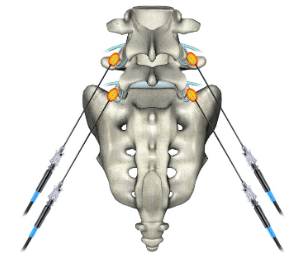Radio-Frequency Ablation (RFA)
(Cervical, Lumbar, Genicular)
Radio-Frequency ablation is a procedure using a specialized machine that generates radio-frequency current. A special needle is places next to the nerve that carries pain from spinal facet joints to the spinal cord. The radio-frequency current is passed through the needle. The current generates heat or other physical forces that interrupts transmission of the pain. These nerves recover function slowly over time.
Frequently Asked Questions
How is the procedure performed?
The procedure is performed under x-ray guidance with the patient lying on his/her stomach. The skin is anesthetized and the needles are placed under x-ray guidance.
How long does the effect last?
The effect of the procedure is expected to last anywhere from 3 months to 12 months. Again, everyone is different and there is great variability among patients.
Can RFA treatment be repeated?
This depends on how long it takes for the nerve function to return. In general, because of risks of repeated x-ray exposure, we do not recommend more than twice per year, or once every 6 months.
What are the complications of RFA?
Many patients report soreness; often a sunburn feeling to the area treated that can last 1-3 weeks. Ice for 20-minute periods throughout the day can help. Rare complications include infection, bleeding, and nerve damage.
Who can have this procedure?
Prior to initial radio-frequency, you should have at least two successful diagnostic nerve blocks performed (see medial branch block handout).
Who should not have this procedure?
If you are taking antibiotics or if you have any active infection, especially in the area being worked on, you should not have the procedure without further discussion. Also, please warn us of any allergies, especially to local anesthetics, x-ray dye, seafood, and latex.











